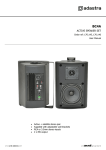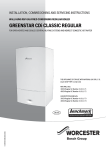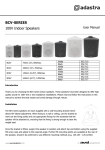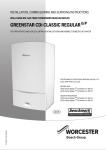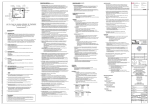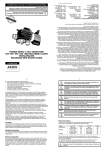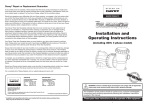Download Heat Pump Installation, Maintenance and Service Manual
Transcript
Heat Pump Installation, Maintenance and Service Manual This booklet is to be carefully read and instructions followed for efficient and trouble free operation of the Accent Swimming Pool Heat Pump 21 Atkinson Street Liverpool NSW 2170 ABN 28 062 383 224 Tel: (02) 8706 8400 Fax: (02) 8706 8477 TABLE OF CONTENTS INTRODUCTION .................................................................................................. 1 SECTION 1 INSTALLATION .............................................................................. 2 Site Location, Preparation & Unit Positioning ..................................................................2 Plumbing ..........................................................................................................................3 Chemical Treatment.........................................................................................................3 Electrical...........................................................................................................................4 Control Design for Pool Heating.......................................................................................4 Link between Heat Pump, Water Pump and Thermostat for Pool Heating ......................4 SECTION 2 COMMISSIONING........................................................................... 5 SECTION 3 OPERATION ................................................................................... 6 Swimming Pools & Spas .................................................................................................6 Thermostat Operation .....................................................................................................6 Heat Up Time ..................................................................................................................6 De-Icing...........................................................................................................................6 Pool Application ..............................................................................................................6 SECTION 4 MAINTENANCE .............................................................................. 7 Heat Exchanger Care.......................................................................................................7 SECTION 5 TROUBLESHOOTING ..................................................................... 8 Machine Will Not Start ....................................................................................................8 Pool Will Not Heat ...........................................................................................................8 Compressor Will Not Run................................................................................................8 Compressor Motor Hums But Will Not Start....................................................................8 SECTION 6 INSTALLATION SCHEMATIC DRAWINGS...................................... 9 Typical Single Pool Heat Pump Schematic For Pool Filtration ......................................9 Typical Single Pool Heating Schematic.........................................................................9 Typical Multiple Pool Heat Pump Installation ..............................................................10 Typical Schematic for Single Hot Water Heat Pump ...................................................10 INTRODUCTION Accent Hot Water Heat Pumps are available in sizes from 8kW to 375kW nominal output. The units are most commonly manufactured as air-to-water design, in which it extracts heat from ambient air and transfer it into the water, to provide the most cost efficient method of water heating. The units are also manufactured as water-to-water or ground-coupled design. Each is a fully packaged unit, requiring only electrical and water connections to be made on installation. Each is factory charged, with refrigerant R22 being ideally suited for commercial or industrial situations requiring hot water up to 60°C or up to 40°C for pool heating. Accent also now manufactures with R407C and R410A and these refrigerants may be requested. Refrigerant R134a is also used for special hot water applications. As the performance of the Accent Heat Pump varies with ambient operating conditions, water flow, water temperature and also due to the wide diversity of commercial and industrial applications, selection of the unit should be done in conjunction with an experienced heat pump dealer or the manufacturer. Each Accent unit is custom-manufactured to meet specific task/site requirements and a wide range of options is available in unit design. Warm coastal climates may never accumulate ice on the coil. In cooler and/or more volatile climates removal of any ice buildup is essential and various de-ice mechanism options are provided. This manual includes important information in regard to installation, operation, maintenance and servicing and should be retained for the life of the heater. Correct installation and familiarity with the operational guidelines given will ensure that the Heat Pump gives optimal efficiency and trouble-free operation over many years. HWP-INST.DOC Page 1 of 11 30 April 1998 SECTION 1 INSTALLATION For validity of warranty, installation must be carried out by registered trade person. Site Location, Preparation & Unit Positioning • Heat Pump heating efficiency and output increases with the rise in entering air temperature and as such, it is not necessary for the unit to be placed in sunlight in the manner of a solar heating system. On the other hand, direct sunlight to the evaporator may provide a marginal increase in heat transfer and would assist in the removal of ice formation in cold climate locations. • Locating the Heat Pump close to other system equipment like filter, pump, tank, etc will minimise friction and heat losses. • Free circulation of air across the coil, requires no obstructions on the intake or fan discharge of Heat Pumps. Do not position the unit with any intake side closer than 600mm to adjacent wall, fences, hedges, etc. Ensure that walls, eaves, etc do not obstruct the release of discharge air such that this may recirculate in the incoming air stream of the unit. • Service access is required at both ends of the Heat Pump. Allow a minimum 1,000mm service access at the compressor end if possible. • Where multiple Accents are to be installed, allow 1,500mm minimum clearance between units. • The Heat Pump requires a firm base, say concrete slab. Rubber mounts can be installed between the unit and slab. • Local building authorities should be consulted for regulations concerning minimum installation distance from pool or other amenities. • Units to be used in areas having corrosive atmospheres, must be specified at time of ordering. Manufacture options include epoxy coating of the evaporative coils or provision of lint filters, etc. • Consideration should be given to the operating noise, wherever possible the exhaust should be directed away from the occupied areas. • Drainage of condensate and entering rain water etc will occur at drainage points provided in the plumbing end of the unit. To ensure proper drainage, make sure that the unit is located at a slightly tilted angle with the drain on the downhill side of the unit. This can be done by making the concrete slab slightly higher at one end or lifting one end of the unit by rubber mounts. If the unit is to be installed internally, it is recommended that it sit within a separate drip tray, with provision for drainage of this water to a drain, etc. Ideally, the condensate drain provision connected to the heat pump drip tray or to the drainage points in the heat pump should be flexible and our readily removed for cleaning. Clear plastic connections at the drain will allow the owner to check that debris/dust etc has not choked the condensate drains. It is important that water is not allowed to pond within the unit so as to avoid corrosion to the base of the compressor or heat exchangers. • For the plant-room installation, make sure that sufficient fresh air is available via provision of inlet grills in building design, etc. Exhaust air from the Heat Pump must be discharged by a duct away from the fresh air supply. Never install in an enclosed area. HWP-INST.DOC Page 2 of 11 30 April 1998 Plumbing • It is preferable that the heat pump is connected to filtered water. • It is essential that the water recirculating pump and pipe sizes be engineered to suit the particular application, giving correct water flow through the heat pump. Inadequate or excessive water flow detracts from heating efficiency and can lead to damage to the unit. Selection of the recirculating pump must be made in accordance with the design flow rate and pressure as per the manufacturer’s specification. • Consult manufacturers recommendations for optimum flow rate. Assistance will be provided in relation to optimum plumbing design and pump selection. • Water connections on the unit are clearly marked as water inlet and water outlet. The water lines should be as short as conditions will permit. The size of these lines is not necessarily the same as unit connections. • The installation of breakable unions on both inlet and outlet pipes will facilitate maintenance and water drainage of the system. If the unit is situated below the pool level or an open holding tank, shut off valves should be fitted on the water side of both unions so that removal of the machine is possible without draining the system. • Swimming pool applications. A separate circuit upstream of the water treatment plant is generally the most desirable plumbing configuration with individual flow and return line and filter strainer. This may not always be possible particularly with established pools. Heat pumps plumbed in the line with existing filter equipment can be successfully, although thought must be given to correct flow, run time and possible over chlorinating and/or dosing by extended running of automatic chlorinator, feeders, etc. Typical plumbing schematics for installation with existing filtration and with a dedicated heating circuit are shown in Diagrams 1 and 2. • A one-way check valve should be installed on the outlet of the heat pump. • Hot Water Applications. Diagram 4 shows a typical plumbing schematic. • Models without an internal water flow by-pass must have an external by-pass fitted. • Where multiple units are installed, the heaters must be installed in parallel to equalise pressure drops and balance flow through the heaters. Systems of three or more Heat Pumps require a plumbing loop. • All Plumbing should be carried out by qualified tradesman. Chemical Treatment Heat Pumps are warranted only for pure filtered water (swimming pools, spas) or mains water (hot water) applications. For maintenance of Heat Pumps applied to swimming pools or spas, the correct chemical balance of the water circulated through the Heat Pump is very important, to prevent damage to the heat exchanger. The following chemical balance must be maintained; • • • • • pH to be kept between 7.2 and 7.8 Alkalinity must not exceed 200 PPM Free available chlorine must not exceed 6.0 PPM Chemicals must be added down stream side of the Heat Pump. In line chlorinator must be installed down stream of the Heat Pump. HWP-INST.DOC Page 3 of 11 30 April 1998 The maintenance of the above guidelines does not in itself ensure that water is in balance and non-corrosive. Various mechanisms are available to monitor water conditions and information on the Langlier Saturation Index is provided as a commonly applied industry standard. Electrical • All electrical work must be carried out by licensed electricians and all the wiring should be carried out to AS3000 latest edition wiring standards. • Refer to the internal electrical wiring diagram supplied with the units before proceeding with electrical work. Cable and fuse sizing must be correct relative to unit specified Volts/Hz/Phase. • An isolating switch must be fitted adjacent to the Heat Pump • Do not earth other accessories back to the unit. • To connect power, remove the electrical service panel. Enter wire through the conduit entrance. Ground to lug. Line voltage to contactor terminals L1 and L2 and L3 if unit is three phase. • Water must be running through the unit before it is able to be switched on. Control Design for Pool Heating Heat pumps intended for individual installation to a pool are manufactured with in-built thermostat control and flow switch. • The thermostat is mounted either on the outside panel or internally in the compressor compartment. The controller displays entering water temperature, with the sensor being located in a well to the inlet water pipe inside the unit. • The flow switch is a safety feature to ensure that the Heat Pump runs only when there is adequate water flow. If water flow is disturbed by backwashing, etc, or inadequate, the unit will lock-out by this safety feature. The unit must be manually reset, by turning OFF, then ON. (See Troubleshooting). For systems comprised of multiple Heat Pump units, the thermostat sensor and well may be provided as follows depending on client requirement: • Provided loose to allow installation of thermostat controller display in heat pump control panel (located separately to the heat pumps) with well and probe installed in the pool pipe work on the inlet side of the heat pumps or in the pool itself. • Provided in the nominated lead-unit (i.e. the control heat pump) with relays fitted to the slave units to allow control wiring to be run to these units. Link between Heat Pump, Water Pump and Thermostat for Pool Heating The thermostat sensor is the controlling device in the heating system. This determines whether the heat pump unit should run and is activated in response to the parameters set for pool temperature control. That is, the heat pump will run when the entering water temperature (EWT) is less than the desired set point (normally with a -1°C split) and stop running when the EWT is a set point. The heat pump will likewise not run without water flow so there is a very direct link between the heat pump, pool water recirculating pump and thermostat controller. In situations where the heat pump is installed into the existing pool filtration system, the operation of the heat pump will be controlled by pool temperature at times when the recirculating pump is running. If the recirculating pump is time-clocked to suit filtration routines, then the period of power supply to the filter pump may need to be progressively expanded with cooler air temperatures (as the heater will need to run longer hours than filtration needs in cooler months). If not automated, chlorination settings may also need adjustment. By contrast, in warmer months the heat pump will HWP-INST.DOC Page 4 of 11 30 April 1998 run less hours than the filter. The heat pump may be left ON, (i.e. with power supply), as it will only run if the pool temperature falls below the desired set point by -1°C. Where the Heat Pump is installed on a separate heating circuit (i.e. separate recirculating pump), the thermostat well on the inlet side of the unit will control its operating hours (run-hours). Where the sensor is located within the heat pump, the recirculating pump must run constantly (even if the pool is at temperature) in order to provide water flow and a means of temperature measurement. The common approach in these circumstances is to time clock the recirculating pump. This has the advantage of reducing pump run-hours but means that the pool owner must remain aware that the heating capacity of the system is tied to the available run-hours. As described above, the pool owner must be aware to widen the period of power supply with colder weather. The most efficient approach is for the thermostat sensor to be located either in the pool or balance tank with control wiring back to the water pump. The operation of the pump will be controlled by pool temperature, with water flow to the heat pump activating its operation. This approach reduces recirculating pump and heat pump run-hours and duty. SECTION 2 COMMISSIONING The Accent heat pump is fully charged with refrigerant. The following checks should be carried out: 1. Installation and operation instructions should be read prior to commissioning. 2. The unit should have unrestricted supply of fresh air to the coil and exhaust air removed from close in areas. 3. The unit should stand on a firm level base. 4. Noise should be directed away from living areas. 5. Water connected correctly as indicated. 6. Any chemicals are introduced downstream of unit. 7. Condensate drain runs to waste. 8. Unit is wired correctly and has full amperage, 9. Unit is not to be started without flow of water. 10. The thermostat and reset button are set. 11. Three phase fans and scroll compressors are running in correct rotation. HWP-INST.DOC Page 5 of 11 30 April 1998 SECTION 3 OPERATION Swimming Pools & Spas 1. The Heat Pump unit has an internal thermostat, located at the control panel, which maintains the outlet water at the selected temperature. The normal operating temperature range is 25°to 40°C. 2. Select a suitable temperature about 38°C for spa and 28°C for pools. 3. The unit is fully automatic and after commissioning, can be started by pressing a start button, and providing water flow through the Heat Pump. 4. In low ambient temperature ice may form on the evaporator coil. If this occurs the machine will automatically go into defrost operation. 5. The unit can be controlled via time-clock through water pump. The unit has in-built water pressure switch and will sense water flow to start unit. 6. Running Time ~ The Heat Pump is controlled by a thermostat which will switch the unit off when the set temperature is reached. The running time will vary with the weather, amount of wind, length of time the pool cover is off and the pool usage. As this is an automatic operation, manual switching is not necessary, i.e. allow the Heat Pump to monitor the pool temperature. Long periods of being switched off will make the units job more difficult, especially when a constant temperature is desired. Thermostat Operation The temperature shown in normal display mode is the entering water temperature (i.e. the current water temperature). To check current set-point temperature, push the top left hand button Α (may be illustrated as a thermometer), on the control panel to display the temperature screen. To increase the temperature push the up arrow key à , to decrease the temperature push the Ä down arrow key. Storage occurs immediately after programming. Heating occurs between the set point temperature and a lower set point, determined by the lag programmed by the key HYS. Generally, the lag is negative 1°C, meaning that heating will occur at set point less 1°C. Heating will stop when set point is reached. To display the lag, press HYS. To increase the lag push the up arrow key à , to decrease the lag push the Ä down arrow key. Storage occurs immediately after programming. Heat Up Time Heat up time on pool and spa will vary depending on outside air temperature, wind speed over pool, amount of sun on pool, unit size and running time available. To maintain temperature and reduce running cost a heat retention blanket must be used overnight or whenever pool or spa is not in use. De-Icing Pool Application Refrigerant hot gas by-pass is intended for locations where ice build-up on cooling coils will be occasionally experienced. Reverse cycle de-icing system is intended where ambient temperatures are likely to fall below 5°C for prolonged periods. HWP-INST.DOC Page 6 of 11 30 April 1998 SECTION 4 MAINTENANCE 1. Depending on the location of the unit, fins of the coil must be cleaned periodically. 2. In locations where ambient temperature can be very low, if unit is not used for a long period, it is essential to drain all water from unit to prevent ice build-up in water pipe-work. 3. Leak test refrigerant system once every 6 months. 4. Check pressure switches, de-ice control and solenoid valves if fitted. 5. Check thermostat. 6. Check fan motor support and fan blades. 7. Check condensate drain for blockages. 8. Check water inlet and outlet connections for any leaks. 9. Check current draw with and without load. 10. Check operating voltage at compressor terminal with load, without load and at start-up. 11. A minimum program of servicing every four months is recommended and should be undertaken by a specialist refrigeration mechanic. 12. The unit casing is designed for outdoors installation and no specific maintenance should be necessary. If the case is cleaned, ensure that power to the unit is switched off. 13. Clean evaporator coils. If coils are becoming clogged with leaves or debris, remove any surrounding source of leaf or other litter. Heat Exchanger Care • Care should be taken of the heat exchanger by correct approach to chemical treatment and seasonal shut-downs. Always allow water to pass through the heater, even if the heater is not being used. If the heater is isolated with chlorinated water or in its water piping, chlorine gases may corrode the heat exchanger. Manufacturers void warranties for chemical abuse and chemical corrosion is easily diagnosed at the factory. • For shutdowns in locations experiencing freezing conditions, the piping system and heater must be drained. The heater should be flushed with clean fresh water for several minutes to wash away all traces of chemicals, then drained. It is recommended that the entire system is purged using pressurised air to force remaining water from the system. • Undertake regular checks of water chemical balance. • If water enters the refrigeration system due to heat exchanger failure, contact supplier for advice. HWP-INST.DOC Page 7 of 11 30 April 1998 SECTION 5 TROUBLESHOOTING Machine Will Not Start As a safety feature, the Heat Pump has a programmed time delay between provision of power and unit start, usually a few minutes. Wait for this time delay before making the following checks: • • • • • Check electrical supply to the unit is ON. Check water flow Check electrical for loose connections and wiring. Check supply fuse. Check thermostat is correctly set. Pool Will Not Heat • • • • • • • • Check that the ejected air temperature is colder than incoming air. If so, this means the unit is extracting heat from the air and transferring this to water. Check that the evaporator and internal pipes sweating. This is evidence of heat removal from the air, suggesting that the heater is working. Check inlet louvres, outlet grill and condenser coil has satisfactory airflow and is not clogged. Check that thermostat is correctly set Check that water pump is running Check water filter is operational Check that inlet valves are not closed Check ambient air temperature suits design standards The initial temperature rise for swimming pool heating may seem slow but the unit is probably working. Heat pumps have a much lower KW/MJ per hour heat output capacity than gas and will need to operate for more time to deliver the same heat transfer. Compressor Will Not Run Possible Cause Overload switch cut-out Possible Solution Find cause of overload and push reset button. System stopped on safety lockout A disturbance in water flow may have triggered the safety lockout. Reset unit by switching OFF, then back to ON. If unit does not respond, fit gauges and check refrigerant charge and HP/LP operation. Possible condenser water flow failure. Check condenser pump water entering temperature and flow rate. Motor windings faulty Contact manufacturer for replacement. Compressor Motor Hums But Will Not Start Possible Cause Possible Solution Low voltage Provide adequate voltage. Wrong motor connections Check with name plate or wiring diagram. Tight or seized compressor Repair or replace. No power on one phase Check circuit breakers, main switch and wiring for fault. HWP-INST.DOC Page 8 of 11 30 April 1998 SECTION 6 INSTALLATION SCHEMATIC DRAWINGS Typical Single Pool Heat Pump Schematic For Pool Filtration CHEMICAL INPUT MUST BE DOWN STREAM OF HEAT PUMP OUTLET CHECK VALVE POOL CHLORINATOR BALANCE VALVE OPTIONAL INLET HEAT PUMP FILTER PIPE SCHEMATIC FOR HEAT PUMP INSTALLED INTO POOL FILTRATION SYSTEM. PUMP SUPPLY FROM POOL RETURN TO POOL Typical Single Pool Heating Schematic CHEMICAL INPUT MUST BE DOWN STREAM OF HEAT PUMP FILTER POOL CHLORINATOR PUMP CHECK VALVE OUTLET SUPPLY FROM POOL INLET RETURN TO POOL PUMP PIPE SCHEMATIC FOR HEAT PUMP INSTALLED WITH SEPARATE PUMP FOR HEATING APPLICATION. HWP-INST.DOC Page 9 of 11 30 April 1998 Typical Multiple Pool Heat Pump Installation BUTTERFLY VALVE OUTLET BUTTERFLY VALVE INLET BUTTERFLY VALVE OUTLET BUTTERFLY VALVE INLET BUTTERFLY VALVE OUTLET BUTTERFLY VALVE INLET 80mmØ TANK FILTRATION PUMP HEAT PUMP 100mmØ STEEL FLANGE 250Ø PVC FLANGE RETURN TO POOL FROM POOL 80mmØ 80mmØ HEAT PUMP 100mmØ INLINE PUMP FLANGES 100mmØ BUTTERFLY VALVE CHECK VALVE 100mmØ BUTTERFLY VALVE 100mmØ 80mmØ 80mmØ 36m 16 2 1 4 6 1 6 x x x x x x x x 100mm 100mm 100mm 100mm 100mm 100-80mm 100mm 80mm PIPE, CLASS 9x6 ELBOW BUTTERFLY VALVE STEEL FLANGE TEE REDUCING BRUSH CHECK VALVE BUTTERFLY Accent Air 24m 18 2L 6 10 12 x 80mm x 80mm HEAT PUMP PIPE, CLASS 9 ELBOW PRIMER GLUE HANGER FLANGES PVC FLANGES x 100mm x 100mm x 80mm PTY LTD ACCENT ON QUALITY AIR CONDITIONING EQUIPMENT UNIT 9, 16 BARRY ROAD; CHIPPING NORTON NSW 2170 TEL: (02) 9755-2855, FAX: (02) 9755-5098 DWG NO: SCHEM-1 Typical Schematic for Single Hot Water Heat Pump HOT WATER OUT OUTLET RETURN TO TANK GATE VALVE INLET GATE VALVE STORAGE TANK CHECK VALVE T'STAT WELL Y-STRAINER GATE VALVE PUMP MAIN'S WATER IN PIPE SCHEMATIC FOR HOT WATER HEAT PUMP HWP-INST.DOC Page 10 of 11 30 April 1998













